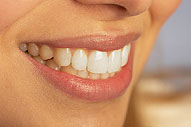[vc_row top_margin=”none” el_position=”first last”] [vc_column top_margin=”none” width=”1/2″] [vc_nested_accordion top_margin=”none” active=”1″ el_position=”first last”] [vc_nested_accordion_tab title=”Veneers” tab_id=”Veneers”] [vc_column_text el_position=”first last”]
Teeth that are badly stained, shaped or crooked may be improved by a veneer placed on the surface of the affected teeth.
Veneers are thin pieces of porcelain or plastic cemented over the front of your teeth to change their color or shape. Veneers are used on teeth with uneven surfaces or are chipped, discolored, oddly shaped, unevenly spaced or crooked. Little or no anesthesia is needed. Veneers have a longer life expectancy and color stability than bonding, and highly resist permanent staining from coffee, tea, or even cigarette smoking.
Veneers are usually made by a dental lab technician working from a model provided by your dentist. Veneers are usually irreversible because it`s necessary to remove a small amount of enamel from your teeth to accommodate the shell.
Porcelain veneers can mask undesirable defects, such as teeth stained by tetracycline, by an injury, or as a result of a root-canal procedure, and are ideal for masking discolored fillings in front teeth. Patients with gaps between their front teeth or teeth that are chipped or worn may consider porcelain veneers.
Typically, veneers entail at least three appointments: diagnosis and treatment planning, preparation, and bonding.
During the tooth preparation visit, usually lasting one to two hours, the teeth are lightly buffed to allow for the small added thickness of the veneer. Usually, about a half a millimeter of the tooth is removed, which may require a local anesthetic. During the same visit, a mold is taken of the teeth, and sent to the laboratory for the fabrication of the veneers.
During the final “bonding” visit, also about one or two hours, the veneers are placed on the tooth surface with water or glycerin on the teeth to check their fit and get a sense of the shade or color. While the veneers are resting on your teeth, they can be adjusted with various shades of cement to match the color of your teeth. To apply the veneer, the tooth is cleansed with specific chemicals to achieve a bond. Once a special cement is sandwiched between the veneer and tooth, a visible light beam, or laser, causes a catalyst to be released, hardening the cement.
During a two-week period of adjustment that follows, you may notice the change of size and shape in your teeth. It is important to brush and floss daily. After one or two weeks, you`ll return for a follow-up appointment. Porcelain veneers are reasonable facsimiles of natural teeth, not perfect replacements. It`s not uncommon to see slight variations in the color of porcelain veneers upon close inspection, as this occurs even in natural teeth.
For certain patients no preparation of the teeth may be necessary. Please see our specialties page for more information.
[/vc_column_text] [/vc_nested_accordion_tab] [vc_nested_accordion_tab title=”Teeth Whitening” tab_id=”Teeth_Whitening”] [vc_column_text el_position=”first last”]
Whitening procedures have effectively restored the smile of people with stained, dull, or discolored teeth.
The darker tissue of your teeth, the dentin, can become exposed as the outer layer of enamel is worn away by the effects of aging or things like caffeine and tobacco.
Food particles are naturally attracted to a tooth’s enamel by a certain protein. Products like coffee and tea, berries and soy sauce are notorious for staining teeth. Over time, teeth actually become more absorbent and vulnerable to staining from food and other substances.
One type of stain—caused by traumatic injuries, medications and fluorosis—actually begins inside the tooth; brushing and flossing don’t help. Another type of stain—one that can be more easily attacked by brushing, flossing and rinsing—is caused by external factors such as foods.
More and more people today are choosing tooth-whitening procedures to reverse the effects of aging and abuse from food and tobacco stains.
Some commercially available “whitening toothpastes” can be somewhat effective at removing stains and making teeth a few shades brighter. However, many of these products have abrasive substances that can actually wear away your tooth’s enamel.
Whitening agents actually change the color of your teeth, but only are effective on certain types of stains. For example, bleaching agents have a difficult time removing brownish or grayish stains. These products also are not as effective on pitted or badly discolored teeth, or on restorations such as crowns, bridges, bonding and tooth-colored fillings (porcelain veneers or dental bonding may be more appropriate in this case).
Professional whitening performed by our office is considered to be the most effective and safest method; done properly, tooth whitening can last as long as five years. Over-the-counter whitening systems are somewhat effective as long as they are monitored and directions followed closely.
[/vc_column_text] [/vc_nested_accordion_tab] [vc_nested_accordion_tab title=”Bleaching” tab_id=”Bleaching”] [vc_column_text el_position=”first last”]
Bleaching and non-bleaching products are the two basic kinds of whitening products available today.
Non-bleaching products normally use abrasives or chemicals and only remove surface stains on teeth.
Bleaching products work with a chemical called peroxide and can brighten your teeth several shades.
Another process employs the use of a special gel that is placed inside a flexible device you wear around your teeth for a certain period of time. After you remove the device, you must use a second bleaching agent, followed by a special light to activate the chemical action.
Mildly stained teeth usually only require one session of bleaching.
[/vc_column_text] [/vc_nested_accordion_tab] [vc_nested_accordion_tab title=”Chipped Cracked And Worn Teeth” tab_id=”Chipped_Cracked_And_Worn_Teeth”] [vc_column_text el_position=”first last”]
Special thin laminates, called veneers, can often be used to correct discolored, worn down, cracked and chipped teeth. Veneers can also be used to close unsightly gaps between teeth. Stronger types of veneers made of porcelain, also called composite veneers, typically last longer because they are bonded to the tooth.
Another process called bonding can accomplish some of the same things, but it does not last as long. Material that looks much like the enamel on your teeth is used during a bonding procedure. The material is shaped to the tooth, and when it becomes hard it is polished.
In addition, dental contouring and reshaping can correct chipped, cracked, crooked, or even overlapping teeth. This procedure can alter the shape, length, or position of teeth.
[/vc_column_text] [/vc_nested_accordion_tab] [vc_nested_accordion_tab title=”Implants” tab_id=”Implants”] [vc_column_text el_position=”first last”]
Before development of dental implants, dentures were the only alternative to replacing a missing tooth or teeth.
Implants are synthetic structures that are placed in the area of the tooth normally occupied by the root. Implants are anchored to the jawbone or metal framework on the bone and act as a foundation for an artificial tooth or permanent bridge. In some cases, implants can be used to attach dentures.
Not everyone is a candidate for a dental implant, however. For a successful implant to take hold, a candidate must have proper bone density and have a strong immune system. In all cases, dental implants require strict oral hygiene.
Implants are so well designed that they mimic the look and feel of natural teeth. Implants are usually made of a synthetic yet biocompatible material like metal or ceramic.
Surgery is necessary to prepare the area for an implant and place the implant in the mouth. Following the procedure, a period of time is required for the implant to take hold and for bone tissue to build up and anchor the device. In some cases, metal posts are inserted into the implant during a follow-up procedure to connect the tooth.
Because implants require surgery, patients are administered anesthesia and, if necessary, antibiotics to stave off infection following the procedure.
Like any restoration, implants require diligent oral hygiene and proper care to ensure they last a long time.
[/vc_column_text] [/vc_nested_accordion_tab] [vc_nested_accordion_tab title=”Grafts” tab_id=”Grafts”] [vc_column_text el_position=”first last”]
Soft tissue grafts are sometimes performed to treat gum disease, or correct other abnormalities.
The procedure involves taking gum tissue from the palate or another donor source to cover an exposed root in order to even the gum line and reduce sensitivity.
Periodontal procedures are available to stop further dental problems and gum recession, and to improve the aesthetics of your gum line. For example, an exposed tooth root resulting from gum recession may not be causing you pain or sensitivity, but is causing one or more of your teeth to look longer than the others. In other cases, an exposed tooth root causes severe pain because it is exposed to extremes in temperatures or different kinds of food and liquids.
Once contributing factors are controlled, a soft tissue graft procedure will repair the defect and help to prevent additional recession and bone loss.
[/vc_column_text] [/vc_nested_accordion_tab] [vc_nested_accordion_tab title=”Old And Unsightly Fillings” tab_id=”Old_And_Unsightly_Fillings”] [vc_column_text el_position=”first last”]
Newer kinds of fillings made from composite resins and porcelain can restore unsightly fillings; many people are surprised how natural these kinds of filling materials can make a tooth once covered by the old-fashioned silver amalgams.
[/vc_column_text] [/vc_nested_accordion_tab] [vc_nested_accordion_tab title=”Bonding” tab_id=”Bonding”] [vc_column_text el_position=”first last”]
 Bonding is a process in which an enamel-like material is applied to a tooth`s surface, sculpted to an ideal shape, hardened, and then polished for an ideal smile. This procedure usually can be accomplished in a single visit.
Bonding is a process in which an enamel-like material is applied to a tooth`s surface, sculpted to an ideal shape, hardened, and then polished for an ideal smile. This procedure usually can be accomplished in a single visit.
Bonding is often performed in order to fill in gaps or change the color of your teeth. It typically only entails one office visit, and the results last for several years.
Bonding is more susceptible to staining or chipping than other forms of restoration such as veneers. When teeth are chipped or slightly decayed, bonded composite resins may be the material of choice. Bonding also is used as a tooth-colored filling for small cavities and broken or chipped surfaces.
In addition, bonding can be used to close spaces between teeth or cover the entire outside surface of a tooth to change its color and shape. Crowns, also known as caps, are used in cases where other procedures will not be effective. Crowns have the longest life expectancy of all cosmetic restorations, but are the most time consuming.
[/vc_column_text] [/vc_nested_accordion_tab] [vc_nested_accordion_tab title=”Excessive Or Uneven Gums” tab_id=”Excessive_Or_Uneven_Gums”] [vc_column_text el_position=”first last”]
Many people inherit the problem of excessive or uneven gums. An aesthetic surgical procedure called a gum lift can be used to correct this problem.
[/vc_column_text] [/vc_nested_accordion_tab] [vc_nested_accordion_tab title=”Ridge Augmentation” tab_id=”Ridge_Augmentation”] [vc_column_text el_position=”first last”]
If you lose one or more permanent teeth, an indentation may result in the gums and jawbone where the tooth used to be. When no longer holding a tooth in place, the jawbone recedes and the resulting indentation looks unnatural. Ridge augmentation is a procedure that can recapture the natural contour of the gums and jaw. A new tooth can then be created that is natural looking and complements your smile.
[/vc_column_text] [/vc_nested_accordion_tab] [vc_nested_accordion_tab title=”Invisalign” tab_id=”Invisalign”] [vc_column_text el_position=”first last”]
Invisalign’s® invisible, removable, and comfortable aligners will give you the beautiful straight teeth you’ve always wanted. And best of all, no one can tell you’re wearing them. Invisalign® is great for adults and teenagers.
What is Invisalign®?
- Invisalign® is the invisible way to straighten your teeth without braces.
- Invisalign® uses a series of clear, removable aligners to straighten your teeth without metal wires or brackets.
- Invisalign® has been proven effective in clinical research and in orthodontic practices nationwide.
How Does Invisalign® Work?
- You wear each set of aligners for about 2 weeks, removing them only to eat, drink, brush, and floss.
- As you replace each aligner with the next in the series, your teeth will move little by little, week by week – until they have straightened to the their final position.
- You’ll visit us about once every 6 weeks to ensure that your treatment is progressing as planned.
- Total treatment time averages 9 – 15 months and the average number of aligners during treatment is between 18 – 30, but both will vary from case to case.
How Are Aligners Made? You’d Be Amazed…
The aligners are made through a combination of our expertise and 3-D computer imaging technology.
Visit the Invisalign® website
[/vc_column_text] [/vc_nested_accordion_tab] [vc_nested_accordion_tab title=”Crowns And Bridges” tab_id=”Crowns_And_Bridges”] [vc_column_text el_position=”first last”]
Bridges
Bridges are natural-looking dental appliances that can replace a section of missing teeth. Because they are custom-made, bridges are barely noticeable and can restore the natural contour of teeth as well as the proper bite relationship between upper and lower teeth.
Bridges are sometimes referred to as fixed partial dentures, because they are semi-permanent and are bonded to existing teeth or implants. There are several types of fixed dental bridges (cannot be removed), including conventional fixed bridges, cantilever bridges and resin-bonded bridges. Unlike a removable bridge, which you can take out and clean, your dentist can only remove a fixed bridge. .
Porcelain, gold alloys or combinations of materials are usually used to make bridge appliances.
Appliances called implant bridges are attached to an area below the gum tissue, or the bone.
Crowns
Crowns are synthetic caps, usually made of a material like porcelain, placed on the top of a tooth.
Crowns are typically used to restore a tooth’s function and appearance following a restorative procedure such as a root canal. When decay in a tooth has become so advanced that large portions of the tooth must be removed, crowns are often used to restore the tooth.
Crowns are also used to attach bridges, cover implants, prevent a cracked tooth from becoming worse, or an existing filling is in jeopardy of becoming loose or dislocated. Crowns also serve an aesthetic use, and are applied when a discolored or stained tooth needs to be restored to its natural appearance.
Procedures
A tooth must usually be reduced in size to accommodate a crown. An impression is then made from the existing tooth to create a custom-designed crown. The impression is sent to a special lab, which manufactures a custom-designed crown. In some cases, a temporary crown is applied until the permanent crown is ready. Permanent crowns are cemented in place.
Crowns are sometimes confused with veneers, but they are quite different. Veneers are typically applied only to relatively small areas.
Caring For Your Crowns
With proper care, a good quality crown could last up to eight years or longer. It is very important to floss in the area of the crown to avoid excess plaque or collection of debris around the restoration.
Certain behaviors such as jaw clenching or bruxism (teeth grinding) significantly shorten the life of a crown. Moreover, eating brittle foods, ice or hard candy can compromise the adhesion of the crown, or even damage the crown.
[/vc_column_text] [/vc_nested_accordion_tab] [/vc_nested_accordion] [/vc_column] [vc_column top_margin=”none” width=”1/2″] [vc_column_text el_position=”first last”]
Cosmetic Dentistry
People choose esthetic dental procedures surgery for various reasons to repair a defect such as a malformed bite or crooked  teeth, treat an injury, or just improve their overall appearance. Whatever the reason, the ultimate goal is to restore a beautiful smile.
teeth, treat an injury, or just improve their overall appearance. Whatever the reason, the ultimate goal is to restore a beautiful smile.
For these and many other reasons, esthetic dentistry has become a vital and important part of the dental profession.
Common esthetic dental procedures can be performed to correct misshaped, discolored, chipped or missing teeth. They also can be used to change the overall shape of teeth from teeth that are too long or short, have gaps, or simply need to be reshaped.
Some of the more common procedures involve:
Bonding – A procedure in which tooth-colored material is used to close gaps or change tooth color.
Contouring and reshaping – A procedure that straightens crooked, chipped, cracked or overlapping teeth.
Veneers – A procedure in which ultra-thin coatings are placed over the front teeth. Veneers can change the color or shape of your teeth. For example, veneers have been used to correct unevenly spaced, crooked, chipped, oddly shaped or discolored teeth.
Whitening and bleaching – As the term implies, whitening and bleaching, a rapidly increasing procedure, are used to make teeth whiter.
Which techniques should be used to improve your smile? A dental exam will take many factors into consideration, including your overall oral health.
[/vc_column_text] [/vc_column] [/vc_row]
